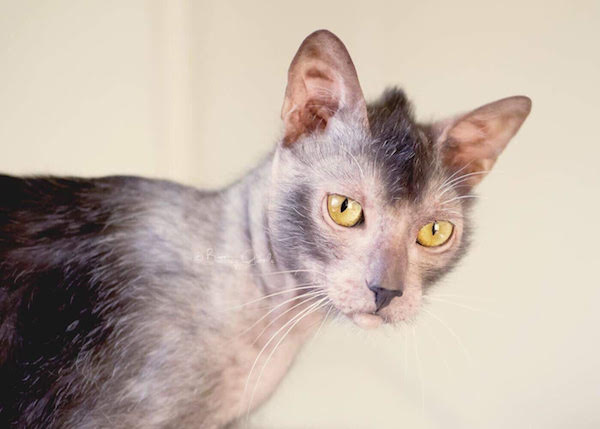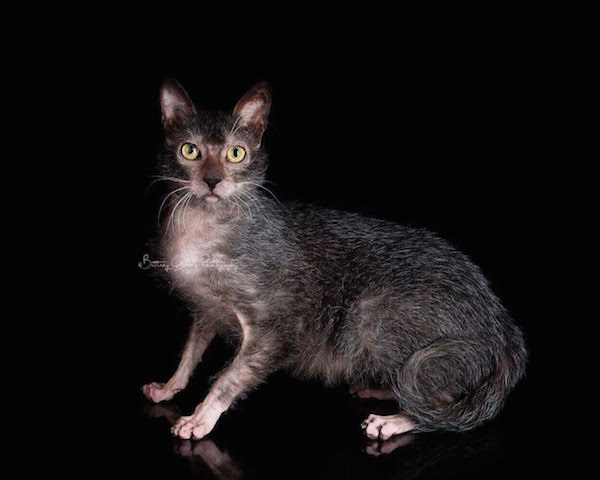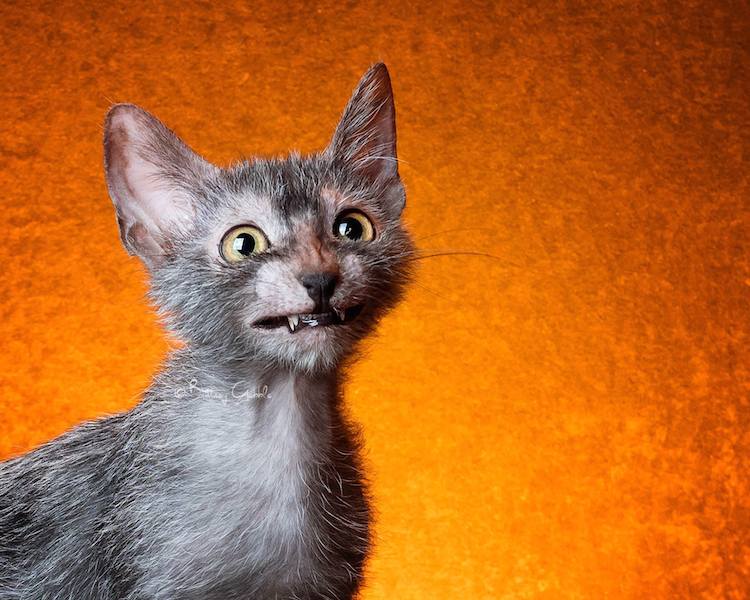“Wolfing Out” aka Molting
These two photos show the same Lykoi.
In one image he is molting, in the other he has his full coat.


Molting…how much hair will they lose?
By Brittney Gobble
Unfortunately there isn’t a “one size fits all” answer to this question. There are several factors at play here. I want to go over some of those factors.
The first factor is bloodlines. The original bloodlines used to found the Lykoi breed had weaker coats. This means that they molted (or wolfed out as we like to say) often, and would have nearly complete hair loss during those molts. Quite dramatic! Several of the newer natural mutation Lykoi that have been added to the program have thicker and more stable coats. This means they molt less often, and not so dramatically (for instance rather than going completely bald, they just lose some patches of hair).
The next factor is climate/temperature. We have found that this can play at least a small part on the coat thickness/stability as well. Cats that are in warmer climates often have thinner coats than cats in a cooler climate. This does not mean a Lykoi from a more stable line is suddenly going to go bald if you move to Florida, nor does it mean your bald Lykoi will grow a coat if you move to Alaska. But let’s say I adopt out two brothers with thinner coats, and one goes to Alaska and one goes to Florida…most likely the one in Alaska will have a slightly thicker coat and molt less than the one in Florida. You would most likely be able to note the difference between those two siblings.
Moving along to the next factor, we have hormones. This is not really much of a factor for pet owners since their kittens are spayed/neutered prior to going home. However for breeders this is a big factor (especially with trying to show your cats!). Between intact cats, it is the males that tend to have the more stable coat. They often do a larger molt around the time they are ready to become a “stud” cat and are mature. We have found the intact females coat to change with each cycle. In some cats that can mean dropping most of the coat, in others it just thins a bit more as the hormones fluctuate. Pregnant females typically get INCREDIBLE coats (much like pregnant human women). Around the time the kittens start to wean we have found the moms (even mothers with wonderful coats) will lose most (or nearly all) of their coat.
One final factor I wanted to discuss is age. We have noticed with age that as the cats molt they seem to not always grow back as much hair as the years pass. Periodically they can surprise us and go two years with very little hair and then suddenly sprout a gorgeous show coat…but that is much less common. Since the breed is still relatively young, I cannot say at this moment if a 10, 15 or 20 year old Lykoi will have less hair than a 3 or 6 year old…we shall all have to continue to study and learn about these amazing cats!
So what about my kitten? What should I expect?
Expect the unexpected!
By Brittney Gobble
Seriously though, no breeder can give you a 100% guarantee as to how the coat will look for a kitten’s entire life. And if the breeder tells you they can…well, I would proceed with extreme caution!
This is something that again depends on the factors above. I have bloodlines that molt every 6-8 weeks. I have bloodlines that molt once per year as adults. I have bloodlines that when they molt they lose almost all the coat, and bloodlines that just lose the hair on their neck.
Where Lykoi molt on their body also varies. I have been quite surprised by how many of my kitten owners email me worried with their kitten’s first molt because they didn’t realize how it works! LOL! Molting can mean they end up with only a Mohawk, or a reverse Mohawk. It can mean they lose all the hair on their heads while having a full coat everywhere else, or just lose all the hair on their hips….basically they can decide to rock whatever hairstyle or male pattern baldness they wish! Sometimes they will rock the same look for several molts in a row, other times they will switch it up! I had one girl that molted only angel wings on her back!
Okay, so what can a breeder tell you? We have found that 9 times out of 10, the kitten in the litter that wolf out the fastest (loses his hair the fastest) will have the thinner or more unstable coat of the litter. The ones that take longer to wolf out, tend to have more stable coats between the littermates. Keep in mind there is still a great degree of variability here depending on which bloodlines are involved. In a litter from lines with weaker coat, that could mean the fastest kitten to molt will have very little hair as an adult (nearly Bald most of the time), and the “best coat” in the litter could still have very little coat (but by comparison to the fastest to molt sibling, he would have a nicer coat). Again, this is not 100% accurate, but it is the best tool a breeder has at this moment. Have I had a baldy that later had the perfect show coat? Yes. Have I had a perfect show coat go bald? Yes. But 9 times out of 10 it comes pretty close to giving an accurate indicator. It is also not something you can look at the kittens as an outsider and determine unless you have seen pictures every day. Because keep this in mind…the fastest to molt is going to grow back in the coat first. So when looking at photos of the entire litter during that time of molting, you may see the little hairy wolfie baby and think “Ah! That one has the best coat! Gimme gimme!”, but that kitten could have already molted long before the siblings and is now growing back in the hair, while the other littermates are just losing their baby coat. And since they did it slower, they haven’t grown it back in yet…which means as adults, they will most likely have better coats. Alos, not all breeders are working with the same bloodlines, so they may or may not have the thicker show coats born as often.So that is something to consider when picking your breeder as well if you are hoping to stack the odds for a certain coat type.
In summary…if coat is a big deal to you, you really need to talk to your breeder! And if the coat looking a certain way is a really BIG deal for you, and it needs to always have that perfect werewolf look…..than the Lykoi probably isn’t the breed for you! Part of the charm of these crazy cats is you never know what stage of wolfing out they will be, or what you will wake up snuggling on any given day!


